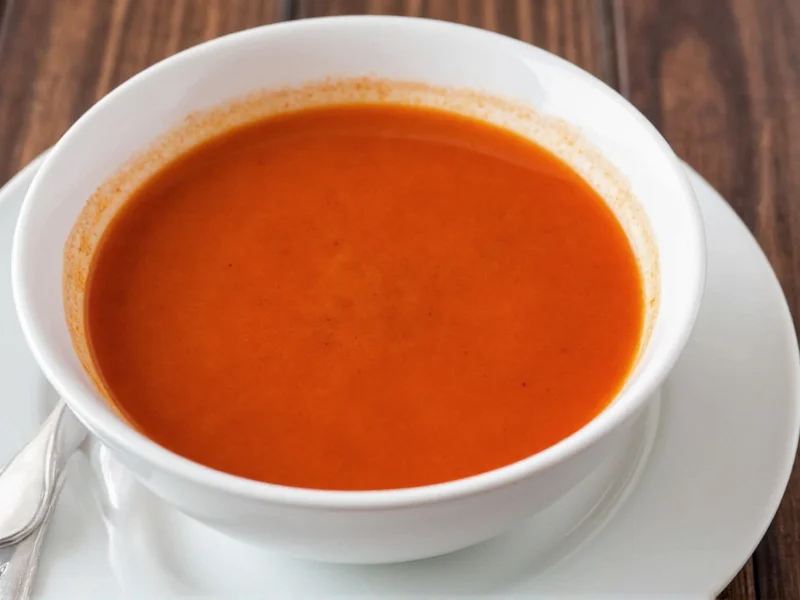Creating exceptional tomato soup requires understanding the balance of acidity, sweetness, and depth of flavor. While many recipes rely on heavy cream, the most authentic versions achieve richness through proper technique rather than added fats. This guide reveals professional methods for making restaurant-quality tomato soup at home with pantry staples.
Essential Ingredients for Flavorful Tomato Soup
The foundation of great tomato soup starts with quality ingredients. While canned tomatoes provide consistent flavor year-round, fresh tomatoes work beautifully in season. Here's what you'll need for a classic version serving 4-6 people:
| Ingredient | Quantity | Why It Matters |
|---|---|---|
| Whole peeled tomatoes | 2 (28-ounce) cans | Provides consistent flavor and texture; San Marzano varieties offer superior sweetness |
| Yellow onion | 1 medium, diced | Adds natural sweetness without overpowering |
| Carrot | 1 medium, finely chopped | Neutral sweetness that balances acidity |
| Garlic | 3 cloves, minced | Essential aromatic base |
| Extra virgin olive oil | 2 tablespoons | Carries flavor compounds and adds richness |
| Vegetable or chicken broth | 2 cups | Provides depth; low-sodium preferred |
| Fresh basil | 1/4 cup, chopped | Adds bright herbal notes |
| Balsamic vinegar | 1-2 teaspoons | Enhances natural sweetness and rounds flavors |
Step-by-Step Cooking Process
Follow these professional techniques to create perfectly balanced tomato soup every time. This easy homemade tomato soup recipe takes just 30 minutes from start to finish.
- Sweat the aromatics: In a large pot, heat olive oil over medium-low heat. Add onions and carrots with a pinch of salt. Cook gently for 8-10 minutes until softened but not browned. This builds flavor without bitterness.
- Add garlic: Stir in minced garlic and cook for 1 minute until fragrant. Be careful not to burn it.
- Incorporate tomatoes: Pour in canned tomatoes with their juice. Use scissors to snip tomatoes directly in the can for easier handling.
- Simmer gently: Add broth and bring to a simmer. Reduce heat to low, cover partially, and cook for 20 minutes to allow flavors to meld.
- Blend thoroughly: Using an immersion blender, puree until completely smooth. For extra silky texture, pass through a fine-mesh sieve.
- Finish with acidity: Stir in fresh basil and balsamic vinegar. Taste and adjust seasoning as needed.
Pro Tips for Perfect Tomato Soup Every Time
These professional kitchen techniques transform basic tomato soup into something extraordinary. Understanding these principles helps when making tomato soup from fresh tomatoes or adjusting recipes to your taste.
- Balance acidity naturally: Instead of adding sugar, use a small peeled potato during cooking. It absorbs excess acid while adding subtle sweetness.
- Avoid metallic taste: Never cook tomatoes for extended periods in aluminum pots. Use stainless steel, enameled cast iron, or ceramic cookware.
- Enhance umami: Add a Parmesan rind while simmering for depth of flavor without overpowering the tomato taste.
- Texture control: For creamy tomato soup without cream, blend in 1/4 cup cooked white beans instead of dairy.
- Flavor development: Let soup rest for 24 hours before serving. Tomato flavors deepen significantly overnight.
Common Mistakes to Avoid
Even simple recipes can go wrong without proper technique. These pitfalls frequently undermine the best tomato soup recipe for beginners:
- Rushing the aromatic base: Cooking onions too quickly creates bitterness rather than sweetness
- Over-blending hot soup: Creates pressure that can cause dangerous splatters; cool slightly first
- Adding dairy directly: Causes curdling; temper cream by adding hot soup gradually
- Under-seasoning: Tomatoes require more salt than expected to shine
- Using poor quality canned tomatoes: Opt for whole peeled over diced for better texture
Variations to Customize Your Soup
Once you've mastered the basic technique, experiment with these popular adaptations. This quick tomato soup recipe under 30 minutes works as a foundation for many delicious variations.
- Roasted tomato version: Toss tomatoes with olive oil, salt, and garlic. Roast at 400°F for 30 minutes before adding to soup for deeper flavor
- Spicy arrabbiata style: Add 1/2 teaspoon red pepper flakes with the garlic
- Tomato basil bisque: Increase basil to 1/2 cup and add 2 tablespoons heavy cream at the end
- Vegan creamy version: Blend in 1/2 avocado or 1/4 cup raw cashews soaked in hot water
- Summer fresh tomato soup: Use 3 pounds ripe tomatoes, blanched and peeled, instead of canned
Serving and Storage Recommendations
Proper presentation and storage maintain the quality of your homemade tomato soup. Follow these guidelines for the best results when making tomato soup from scratch.
For serving, ladle hot soup into pre-warmed bowls. Garnish with fresh basil, a drizzle of high-quality olive oil, or a dollop of pesto. Classic pairings include grilled cheese sandwiches, crusty bread, or a simple green salad.
Store cooled soup in airtight containers:
- Refrigerator: Up to 5 days
- Freezer: Up to 3 months (leave headspace for expansion)
When reheating, do so gently over medium-low heat. If soup has thickened, add small amounts of broth or water to reach desired consistency. Never boil reheated tomato soup as it can become bitter.











 浙公网安备
33010002000092号
浙公网安备
33010002000092号 浙B2-20120091-4
浙B2-20120091-4